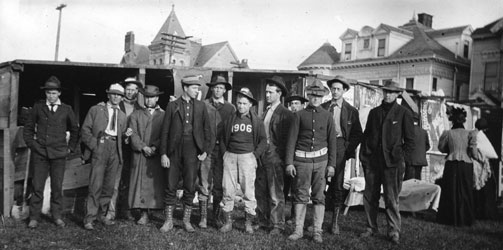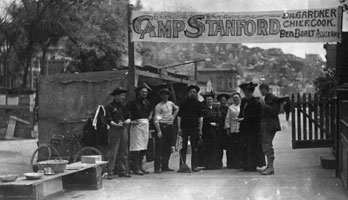|
|
||||||||||
 |
|
|
|
|||||||
|
|
||||||||||
|
|
|
|
|
|
|
|
|
|||
|
|
|
|
|
|
|
|
|
|
|
|
Themes | Student Volunteers
Volunteers at Camp Stanford. |
Almost immediately, relief committees were organized to help the affected in San Francisco and San Jose. Stanford students--including some women--and faculty members headed out to assist where they could. Identification cards, signed by President Jordan, were issued to the students to facilitate their entry into San Francisco, which was under martial law. Some students also wore ribbons or a red cross to label themselves as a resource for those in need. Meetings were held in Palo Alto and on campus to distribute information, request volunteers, and recruit homeowners to welcome refugees fleeing the fires and devastation.
The majority of assistance was directed at San Francisco, where fires burned and many residents were homeless and often helpless. “Camp Stanford,” located at 25th and Guerrero Streets, was home away from home for some of the students. Reverend Charles Gardner of Memorial Church served as cook and kept the volunteers well fed and healthy. Canvass squads were organized to go through neighborhoods taking note of special food, clothing, and medical needs, and recording information about families in need of assistance. Women students worked as canvassers, and also helped Dr. Gardner to prepare meals in his “sidewalk kitchen.”

Stanford men in San Francisco.
